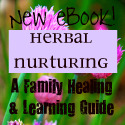Welcome to Domestic by Design! If this is your first time visiting, you may want to start here. Thanks for visiting!
 We’ve already covered steps 1-4, which can be found below if you’re just now joining our series:
We’ve already covered steps 1-4, which can be found below if you’re just now joining our series:
Step 1 – Evaluate Your Presuppositions
Michael Pollan, in his book Food Rules, has a quip that says “If it rots eat it, if it doesn’t, don’t eat it!” (This short book is just as humorous as it is serious, I recommend it!) I think his quip is a wise rule to live by. Many of the “foods” we consume have been loaded with preservatives and chemicals to allow the shelf-life to be longer than normal. If we are working toward a nourishing diet, then highly processed foods need to go.
Let me define what I mean by highly processed. I am intentionally choosing to focus on eliminating highly processed foods because nearly every food item that we purchase will be processed to some extent. I am referring to “foods” have gone through a process in which a significant amount of natural components have been removed or unnatural components have been added. Sometimes, processing a food is good (we can’t just eat beef right off of the cow!), thus, minimally processed foods would almost always be acceptable. However, most times, the processing of a food undermines its nutritional benefits. Many processed foods also contain MSG and GMOs, which we have already discussed. I will address some other foods that you might be surprised about later in the book. For right now, stick with me for a guide as to what is highly processed and how to eliminate it.
You have probably heard the term “real food” tossed around a lot. The term has been coined due to the abundance of products sold to us as “food.” Most of the products are not real food! Inherent in the definition of food is the word “nourishment.” Most food products sold in stores today do not contain many, if any, nourishing qualities. We should not seek to eat just to take away the feeling of hunger, but to nourish and sustain our bodies. Food wasn’t created simply for pleasure, but for a purpose. God knew what He was doing when He created us with a need to eat, and food with amazingly nourishing qualities.
This can be your first guideline to eliminating highly processed foods. Ask yourself, “How or will this nourish me?”
Next, go back to step two which discusses reading food labels. This will be a great guide to helping you decide when you pick up a packaged item of whether or not you should purchase it. A shock to me was learning that there are 954 food additives on the market today! Now, not all of them are unnatural or bad for us, but most of them are. Most of them I could not pronounce. You’ll be able to learn which foods contain MSG and GMOs buy reading the labels, too. From our learning already, we know those should both be avoided.
Please remember that as I mentioned in our very first session on transitioning to nourishing foods, we must be able evaluate our presuppositions about food rationally. The more you learn about certain food items, the more questions you might have and the more shocked you may become. For example, Cheerios aren’t quite as good for us as we have been told. Why? One of the ingredients is Tripotassium Sulfate. Google it and see what you come up with. It’s a harsh cleaning agent! I learned about it during our child birth class several years ago. Wow! This is often a go-to snack for many moms of small kids, but it can easily be replaced by more healthful, homemade alternatives.
Consuming a diet of mostly fresh whole foods will also help transition to eliminating highly processed foods. Instead of having chips with lunch, try some carrots sticks with salsa or a piece of fruit. If this is your goal, you will also find that you can replace many processed foods with better, homemade alternatives. Salad dressings, soups, dips, mixes, cereals…have often undergone processing in which harmful ingredients are added and/or beneficial nutrients are taken away due to the process it undergoes.
Did you know that breakfast cereals are one of the most unhealthy foods sold in grocery stores? In addition to being difficult to digest due to the presence of phytates (we’ll discuss this in a later step! For now, you can read about this here), they are produced at high temperatures causing nutrients to be destroyed. Alternatives to the traditional breakfast cereal can include cooked cereals (such as oatmeal), homemade granola, eggs, etc…there are so many options to be explored!
Check out my ebook for recipe ideas from soups to salad dressings, breakfasts…
Cooking from scratch, though more time-intensive will save you time and money in the end from needless doctor visits. It is rewarding and often better tasting, too. This is a must for eliminating highly processed foods. Meal planning can help tremendously. A little extra time and preparation will go a long way.
A word to women who are seeking to conceive or are pregnant or nursing: we should be even more particular about what we consume. Our nutrition provides the building blocks for a whole new life. What is consumed before, during, and even after pregnancy could possibly prevent conception, cause birth defects, enable nutrient deficiency or other problems in pregnancy (for either mom or baby), and even affect the quality of breast milk while nursing.
One more thing to consider. Sometimes, changing the way we eat is difficult because of our love for food or a certain food in particular. Maybe there are emotional attachments or unhealthy dependencies. I have dealt with this and do deal with it at times still. I suspect that many of you reading this do not smoke. Why don’t you smoke? It is probably because you have learned for many years of the detrimental health effects of it. Smoking has been shown to cause cancer, emphasema…You took the information you were given and did something with it. You came to the conclusion that smoking is harmful to your health, so you have avoided it.
I want to encourage you to prayerfully consider all of these things we are learning about food in the same way. If after learning, we know or have reason to believe that something is harmful to our health, why would we continue to consume it? I have had to evaluate my own attachments or desires for certain food items. Yes, some things have been hard to give up. But, peace and blessing have come from doing what I believe to be better. I have a clear conscience before the Lord and can walk in freedom from sinful dependency or idolatry. Please be willing to consider these things!
Whew! We made it through the first five steps. How are you feeling about it? Are you overwhelmed, empowered, mad, sad, etc.?
We’ll resume Monday with Step 6 in the series. Stay tuned!

















